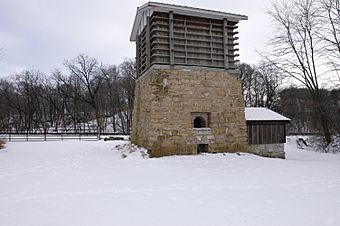Buffalo Grove Lime Kiln facts for kids
Quick facts for kids |
|
|
Buffalo Grove Lime Kiln
|
|

The stone Buffalo Grove Lime Kiln is one of the best preserved perpetual lime kilns in Illinois.
|
|
| Location | Galena Trail Rd., Polo, Illinois |
|---|---|
| Area | 3 acres (1.2 ha) |
| Built | 1870 |
| NRHP reference No. | 02001348 |
| Added to NRHP | November 20, 2002 |
The Buffalo Grove Lime Kiln is a really old building near Polo, Illinois, in Ogle County. It's a special type of oven called a lime kiln. People used it to make something called quicklime. This quicklime was important for things like building and farming.
The Buffalo Grove Lime Kiln is so important that it was added to the National Register of Historic Places in 2002. It's one of only two old lime kilns in Illinois on this special list!
Contents
Where is the Kiln Located?
The Buffalo Grove Lime Kiln is found outside the town of Polo. You can find it off Galena Trail Road. The kiln sits in an old quarry where limestone was dug up. It's about 1,400 feet (427 meters) from the main road.
Right next to the kiln, there are railroad tracks. Buffalo Creek flows just beyond these tracks. Tall bluffs made of limestone are behind the kiln to the north.
What Does the Kiln Look Like?
The Kiln Building
The kiln has special openings called fire boxes on the outside. Inside, there's a tall, hollow column that goes up 25 feet (7.6 meters). The whole kiln was built in 1870 using limestone from the local quarry.
This kiln is a "wood-burning perpetual kiln." This means it had to be kept burning all the time to make quicklime. To keep the heat in, there's a layer of dirt between the outer stone wall and the inner column.
The bottom part of the kiln is a stone base, about 16 feet (4.9 meters) tall. On top of this stone base, there's a wooden structure. This wooden part was rebuilt in 1992 to look like the original. A metal roof with a pointed shape, called a gabled roof, covers the top.
Next to the kiln, there was a "dry shed" or "lime house." This was a storage area. The original shed was gone for a long time, but it was also rebuilt in 1992.
How Big is the Kiln?
Inside the kiln, the special heat-resistant bricks, called fire bricks, form a column. This column is 25 feet (7.6 meters) tall and 6 feet (1.8 meters) wide inside.
At the very bottom of the kiln, there's a 4-foot (1.2-meter) section for cooling the quicklime. Below that are the "draw outs," where the finished quicklime was removed. The main stone base of the kiln is 16 feet (4.9 meters) wide and 16 feet (4.9 meters) high.
The dry shed next to the kiln is 9 feet (2.7 meters) high and 12 feet (3.7 meters) wide. It sits on its own 6-foot (1.8-meter) stone base.
History of the Kiln
The Buffalo Grove Lime Kiln was used for many years, but then it sat empty for decades. In 1985, the Polo Historical Society bought the kiln. They started by clearing away trees and bushes that had grown around it.
A big project to fix up the kiln began in 1992. It cost about $10,000 to restore it. The kiln has a long history, even before the current structure was built.
Fixing Up the Kiln
The restoration project started in 1992. Paul Graehling and the Polo Historical Society led the work. First, they had to remove the old, loose mortar from between the stones. Mortar is like glue that holds stones together.
They replaced it with a new mix of mortar and cement. This new mix helped make sure the repairs would last. The wooden top part of the kiln was completely rotted away. It had to be replaced entirely.
Workers built the new wooden sections somewhere else. Then, a large crane lifted them into place on top of the stone base. Finally, an aluminum roof was put on to protect the kiln from rain and snow.
Because of the new roof, the kiln can't be used to make quicklime anymore. But if the roof were removed, it could still work!
The small building attached to the kiln, the lime house, was also completely restored. When the kiln was working, this room was used for storage. But it had been gone since at least the 1930s.
To rebuild it, they looked at old photographs from the past. The new lime house was built on a stone foundation. They even used old barn wood from the late 1800s to make it look authentic. Just like the kiln, the lime house also got an aluminum roof.
The whole restoration project was finished in 1993. It cost around $10,000 in total.




